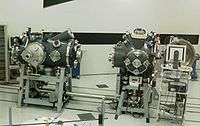X-ray laser
An X-ray laser (or Xaser) is a device that uses stimulated emission to generate or amplify electromagnetic radiation in the near X-ray or extreme ultraviolet region of the spectrum, that is, usually on the order of several of tens of nanometers (nm) wavelength.
Because of high gain in the lasing medium, short upper-state lifetimes (1–100 ps), and problems associated with construction of mirrors that could reflect X-rays, X-ray lasers usually operate without mirrors; the beam of X-rays is generated by a single pass through the gain medium. The emitted radiation, based on amplified spontaneous emission, has relatively low spatial coherence. The line is mostly Doppler broadened, which depends on the ions' temperature.
As the common visible-light laser transitions between electronic or vibrational states correspond to energies up to only about 10 eV, different active media are needed for X-ray lasers. Again, different active media — excited atomic nuclei — must be used if yet higher frequency, gamma ray lasers are to be constructed.
Between 1978 and 1988 in Project Excalibur the U.S. military attempted to develop a nuclear explosion-pumped X-ray laser for ballistic missile defense as part of the "Star Wars" Strategic Defense Initiative (SDI).
X-ray laser active media
The most often used media include highly ionized plasmas, created in a capillary discharge or when a linearly focused optical pulse hits a solid target. In accordance with the Saha ionization equation, the most stable electron configurations are neon-like with 10 electrons remaining and nickel-like with 28 electrons remaining. The electron transitions in highly ionized plasmas usually correspond to energies on the order of hundreds of electron volts (eV).
Common methods for creating X-ray lasers include:
- Capillary plasma-discharge media: In this setup, a several centimeters long capillary made of resistant material (e.g., alumina) confines a high-current, submicrosecond electrical pulse in a low-pressure gas. The Lorentz force causes further compression of the plasma discharge (see pinch). In addition, a pre-ionization electric or optical pulse is often used. An example is the capillary neon-like Ar8+ laser (generating radiation at 47 nm).
- Solid-slab target media: After being hit by an optical pulse, the target emits highly excited plasma. Again, a longer "pre-pulse" is often used for plasma creation and a second, shorter and more energetic pulse is used for further excitation in the plasma volume. For short lifetimes, a sheared excitation pulse may be needed (GRIP - grazing incidence pump). The gradient in the refractive index of the plasma causes the amplified pulse to bend from the target surface, because at the frequencies above resonance the refractive index decreases with matter density. This can be compensated for by using curved targets or multiple targets in series.
- Plasma excited by optical field: At optical densities high enough to cause effective electron tunnelling, or even to suppress the potential barrier (> 1016 W/cm2), it is possible to highly ionize gas without contact with any capillary or target. A collinear setup is usually used, enabling the synchronization of pump and signal pulses.
An alternative amplifying medium is the relativistic electron beam in a free electron laser, which, strictly speaking, uses stimulated Compton scattering instead of stimulated emission.
A different approach to optically induced coherent X-ray generation is high-harmonic generation, stimulated Thomson scattering or radiation produced by oscillating electrons during laser wakefield acceleration.
Applications
Applications of coherent X-ray radiation include research into dense plasmas (not transparent to visible radiation), X-ray microscopy, phase-resolved medical imaging, material surface research, and weaponry.
A soft x-ray laser can perform ablative laser propulsion.
See also
- LCLS X-ray Free Electron Laser at SLAC
- Strategic Defense Initiative X-ray laser and Project Excalibur
- European x-ray free electron laser
- Industrial CT scanning
